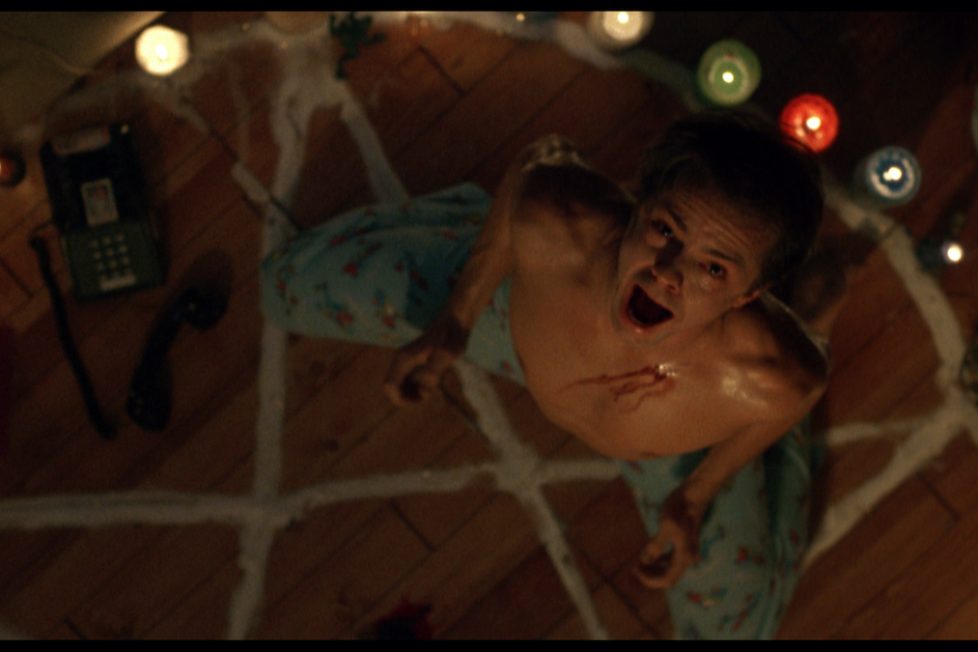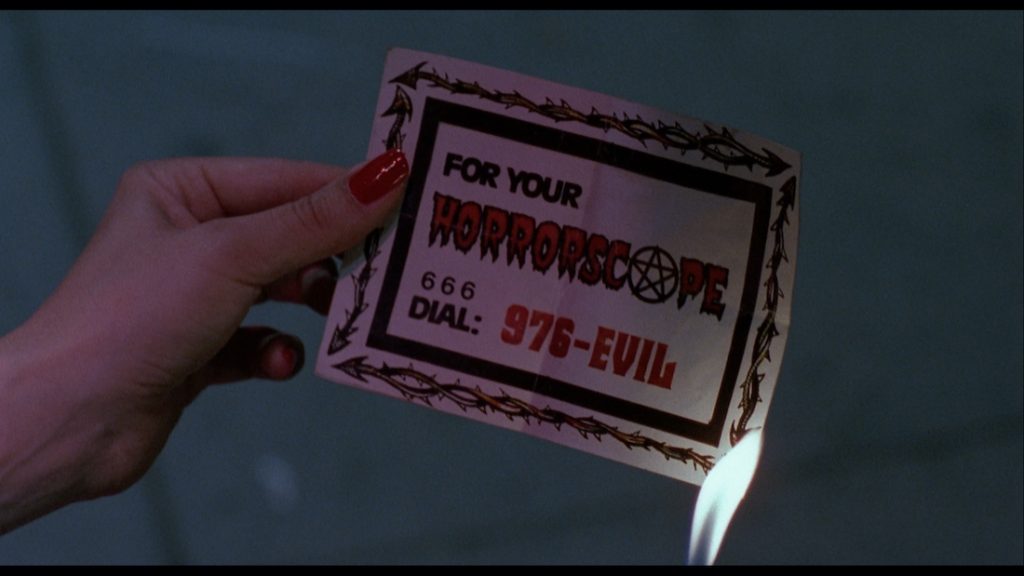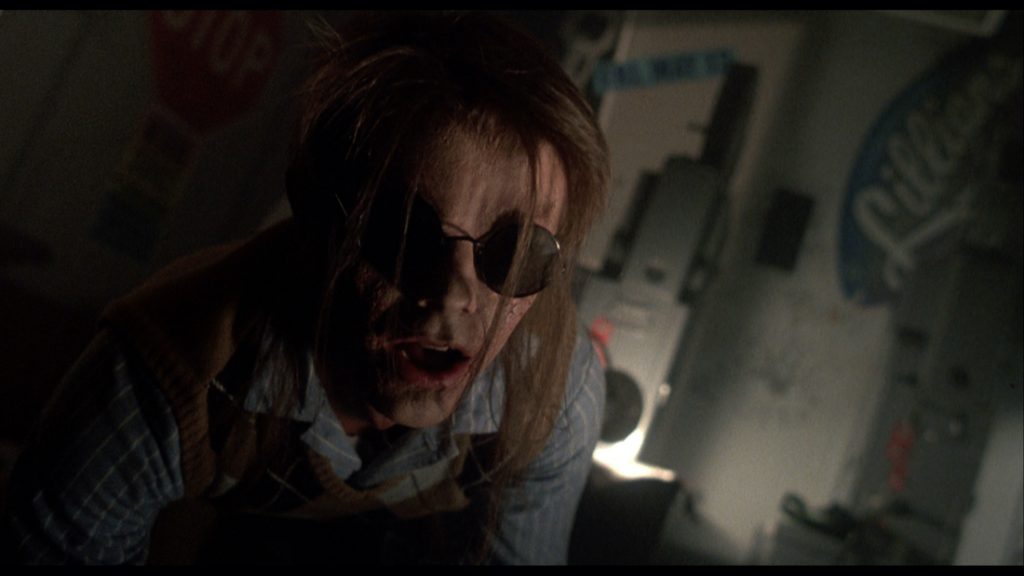976-EVIL (1988)
People who dial 976-EVIL receive supernatural powers and turn into satanic killers.

People who dial 976-EVIL receive supernatural powers and turn into satanic killers.


During the 1980s, every cultural fad or trend inspired a horror movie. Cable TV gave rise to TerroVision (1986) and the home video revolution begat The Video Dead (1987). However, it didn’t stop there. In those pre-internet days, people could call premium-rate telephone numbers (with the prefix ‘976’) for select services. These hotlines would connect you to everything including Michael Jackson’s tour schedule. Then there was the seedy underbelly frequently advertised in the back of men’s magazines, where one could call a middle-aged woman and talk dirty. It was inevitable a horror film would be made about the ’80s phone craze, and it was predictably called 976-EVIL.
1988 was a glorious year for the genre. Tim Burton’s Beetlejuice presented a unique spin on the afterlife, John Carpenter’s They Live imagined alien overlords living amongst us, and there was goofy low-budget fare such as Frank Henenlotter’s Brain Damage and my personal favourite Return of the Living Dead Part II (1988). However, riding the coattails of A Nightmare on Elm Street 4: The Dream Master (1988), was 976-EVIL. After spending four years playing horror icon Freddy Kruger in the Elm Street franchise, actor Robert Englund decided to try his hand behind the camera.

Hoax (Stephen Geoffrey) is a high school student stuck on the outside looking in. Raised in a strict household where his mother’s (Sandy Dennis) religious rules were the law, Hoax now lives with his slightly older cousin Spike (Patrick O’Bryan), who lives life on the edge. Spending most days having his head flushed down the toilet by bullies, Hoax’s schooldays aren’t exactly overflowing with happy memories… so when he finds a card encouraging him to dial ‘976-EVIL’ to find out his ‘horrorscope’, he makes the call and takes the advice. And it works out so well that Hoax ultimately becomes hooked on the service, only to be consumed by a demonic entity that starts to take over his life.
From awkward Hoax through to leather-clad greaser Spike, the characters here are standard ’80s horror types. The eccentric Stephen Geoffrey’s an absolute pleasure to watch in the lead, having come to widespread attention in the horror community for his memorable performance as Evil Ed in Fright Night (1985). Starting out as a painfully shy teenager, after succumbing to Satan’s possession, Hoax’s constant one-liners lend a certain amount of campiness that fits the movie’s tone. His cartoonish performance evokes Jack Nicholson in The Witches of Eastwick (1987) and it’s clear Geoffrey’s having fun here. But the screenplay makes it extremely difficult to sympathise with Hoax. In one scene, after spying on his cousin having sex with his girlfriend, Suzie (Lezlie Dean), Hoax sneaks into Spike’s room and proceeds to steal her underwear. Such psychosexual undercurrents make him appear like a pervert instead of a nerd one can root for.

The rest of the cast throw themselves into the spirit of things to fine effect. Patrick O’Bryan made his screen debut as Spike and returned several years later to reprise his role in the sequel. As Hoax’s troubled cousin who wastes his time playing poker with thugs, Spike’s a bad kid with a good heart, as demonstrated when he beats up several goons in the toilet bullying his cousin. Somewhat like Jason Patric in The Lost Boys (1987), O’Bryan adds a James Dean swagger into the role. Additionally, Sandy Dennis (Parents) obnoxiously chews the scenery as Hoax’s over-protecting mother, a religious fundamentalist who spends most of her time watching TV evangelists in a house filled with paintings of Jesus. She encompasses the worst traits of Piper Laurie’s puritanical mother in Carrie (1976) and Norma Bates. Wearing a fright wig and housecoat, her caricature performance is easily a highlight.
As true fans know, Robert Englund is one of the all-time best character actors of horror. If there was a Mount Rushmore of horror, his face would be etched alongside venerated stars including Boris Karloff (The Old Dark House) and Vincent Price (Laura). However, in the director’s chair, it’s quite the opposite. With only two directing credits to his name, Englund was heavily criticised for his filmmaking skills. Arguably, with his name attached to 976-EVIL, fans and critics alike may have unfairly expected a certain degree of excellence.
Released only several months after A Nightmare on Elm Street 4: The Dream Master, Freddy Kruger was at the height of his popularity, so the standard for Englund to match must have weighed heavily on his shoulders. Respectfully, many of the faults in 976-EVIL are due to Englund’s nativity as a first-time director, but it’s not without some charm. Considering Nightmare on Elm Street 5: Dream Master (1989) was just wrapping production and Freddy’s Nightmares (1988-1990) was underway on television, it’s surprising Englund even found time to direct 976-EVIL as competently as he did.

On the surface, Englund’s approach to directing is inspired by his experiences playing Freddy. With an estimated budget of $2M, the level of blood and gore one would typically expect in an ’80s horror was kept to a minimum. Instead, Englund adhered to a visual aesthetic that evokes a nightmarish, surreal feeling. Everything from the sets, lighting, and VFX seem influenced by A Nightmare on Elm Street (1984). The deserted streets of Los Angeles are coated with a trashy, sleazy veneer, infused with neon-strobe lighting, whereas the high school corridors are being prowled by gangs of youths and every wall is layered in graffiti akin. However, with the help of cinematographer Paul Elliot, who served as Roger Deakins’ second unit DP on No Country for Old Men (2007), Englund makes several stylistic choices that result in some interesting scenes that enhance the surrealism.
One of the macabre highlights happens in the local cinema where Marcus (J.J. Cohens) and his goons play poker. While being chased by a newly possessed Hoax, Marcus hides in a toilet cubicle, and as Hoax appears at the restroom entrance, he slowly makes his way past each empty stall, slamming the doors open with his fists to ratchet up the fear. When he finally gets to Marcus’ cubicle, we see Hoax approach him from an overhead shot. As a bloodcurdling scream rings out, the camera slowly pans across the top of the empty cubicles… eventually returning to the first stall where it’s overflowing with blood. Elliot’s asymmetrical cinematography encapsulates the mood of the movie, making it seem like it’s been torn from the pages of an EC Comic.

As a fan of ’80s B Movie schlock, one of the best aspects of 976-EVIL is that it’s a celluloid embodiment of the genre. It feels as if Freddy Krueger chewed up David Hasselhoff and spat out A Flock of Seagulls. Such a feeling is helped by the incredible work by set designer and Englund’s future wife, Nancy Booth. The majority of the film takes place in the projection room of the El Diablo movie theatre, furnished with one-sheet posters for Maniac (1980), A Clockwork Orange (1971), and a RUN DMC concert flier. However, a personal favourite is the Fright Night poster Hoax stands beside several times. There’s also subtle foreshadowings of the Devil, from the opening scene in a cafe called Dante’s to the “deviled egg sandwich” Spike orders. The sets are brilliantly detailed and littered with an array of easter eggs for horror geeks.
Like it’s contemporaries, 976-EVIL is also full of classic practical VFX. Best-known for designing the Chucky doll in Child’s Play (1988), make-up artist Kevin Yagher and his team create some interesting visuals: from a clowder of cats devouring a character’s abdomen, to a horrific death involving spiders, the onscreen carnage is handled well. The big climax has Hoax transforming into a hideous demon, in three stages, beginning with subtle skin prosthetics and ending with sprouting fangs and claws. It may look outdated but there’s plenty of creative gory effects thanks to animatronics expert Hal Miles’ (The Abyss) too. A standout includes two freshly torn out hearts still pumping while clutched in Hoax’s hands.

Co-written by Brian Helgeland (L.A Confidential) and Rhet Topham (Trick or Treat), it’s not an original horror movie conceit. 976-EVIL contains elements of Evil Speak (1981) as Hoax connects with Satan through a form of technology, while also incorporating the typical revenge of the nerd flick with a Satanic twist, as demonstrated in Fear No Evil (1981). However, unlike the aforementioned horrors, Topham and Helgeland’s screenplay seems confused about who it wants the protagonist to be. There’s a crucial point midway that disrupts the dynamic of the initial set-up. Much like Nancy Thompson in A Nightmare on Elm Street, Hoax is a prominent secondary character throughout the first act, as 976-EVIL only truly begins with Spike’s struggle with Satan’s proposition before ending with Hoax’s jarring Jekyll & Hyde revenge plot. It feels like a medley of two episodes of Tales From the Crypt and Freddy’s Nightmares, stretched to feature-length.
The mordant humour reinforces that Englund is clearly having fun as a director. 976-EVIL boasts its fair share of one-liners Freddy himself might have leered at with approbation. In perhaps the funniest scene, a possessed Hoax walks into a poker game attended by Marcus, and in his hands rest the bloody cardiac muscles he’s just ripped from two of his goons’ chests. Slamming them on to the table, he quips “would it be possible to enter the game with a pair of hearts?” Another wisecrack comes later when Angela (Maria Rubell) discovers a corpse being eaten by cats. Turning round in horror, she bumps into Hoax as he asks “what’s the matter? Cat got your tongue?” It’s difficult to tell if the gags were purposely written by Helgeland and Topham, or if they were added by Englund on-set. It’s certainly a product of its time, causing the humour to be somewhat predictable and typical compared to today’s standards. Regardless, the comedic elements create a sense of playfulness, adding a much-needed charm.
Premium rate phone services are all but extinct today, making 976-EVIL about as relevant as Sandra Bullock’s The Net (1995). However, there’s still lots of fun to be had here. Like a hybrid of Revenge of the Nerds (1984) and the less familiar Party Line (1988), it’s an entertaining 92-minutes. Englund certainly doesn’t have a firm grip on pacing and the narrative could have been tightened, but if you enjoy the goofier horrors of its decade, then 976-EVIL is certainly worth a viewing.
USA | 1988 | 92 MINUTES (THEATRICAL) • 105 MINUTES (VHS CUT) | 1.85:1 | COLOUR | ENGLISH


As usual, Eureka! Entertainment does a great job of delivering a satisfying presentation. 976-EVIL has a robust and enjoyable 1080p HD image on this new Blu-ray. The picture quality boasts a constant grain complementing the picture’s cinematic veneer; details are robust and everything from the plastic coverings on Hoax’s sofa to school graffiti can be seen with clarity.
The colour palette isn’t particularly vibrant during daytime scenes as the image seems a little washed, but as the majority of the film takes place at night it’s not a major issue. The primary colours are also vivid, especially red, and the green neon lights in Dante’s cafe leaps off the screen. Black levels are stable, complimenting the night scenes, and skin tones remain neutral. Occasionally, leftover dust is evident, but it’s to be expected with a film of its age. Overall, it’s a nice picture.
976-EVIL rings with an optional DTS-HD Master Audio 5.1 and LPCM 2.0 soundtrack. The audio isn’t exceptional and fails to take advantage of the soundstage, remaining front-heavy throughout. However, due to the age and condition of the source material, both audio options feature enough stage presence to please. Dialogue propels most of the movie, remaining in the front channels. It’s consistently crisp and clear, prioritising the surrounding elements. Several aggressive sound effects are abundantly potent, such as Spike’s motorbike, ringing telephones, and a handful of chaotic moments. However, they succumb to mild crackles and lack a pure definition. Environmental ambience delivers a moderate sense of immersion, barking dogs, and thunder rumblings surround the rear end speakers fairly. The chilling score from Thomas Chase and Steve Rucker remains at the front-end and can be heard with a clear definition. Personally, I enjoyed the DTS-HD 5.1 over the LPCM 2.0, although there wasn’t much difference between the two.

director: Robert Englund.
writers: Rhet Topham & Brian Helgeland.
starring: Stephen Geoffreys, Jim Metzler, Maria Rubell, Pat O’Bryan & Sandy Dennis.
